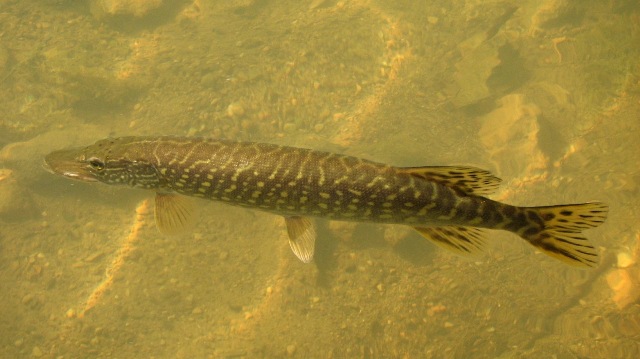Northern Pike
(Esox lucius)

Historically, Northern pike were abundant in Lake Erie and its tributaries, especially in the extensive bays and marshes of the western basin. It is also thought to have been present in some tributaries of the Ohio River.
Description
The Northern pike is a long and slender fish with a duckbill shaped mouth and lots of needle sharp teeth. The dorsal fin is soft and located near the tail fin. In contrast to the muskellunge, the lower half of the opercle (gill cover) does not have scales while the cheek is fully scaled. Northern pike also have numerous white or yellow spots on their sides with a dark green or olive background body coloration. They also have dark spots or wavy lines on their fins. Muskellunge have dark colored markings on a lighter background. Both the grass and chain pickerel do not have any dark markings on their fins.
Habitat and Habits
Northern pike prefer clear water with dense cover in the form of aquatic vegetation or logs and tree limbs. Historically, Northern pike were more abundant than they are today but they are still found in the western basin of Lake Erie including Sandusky Bay, Maumee Bay, and the remaining marshlands. Northern pike can also be found in tributaries to Lake Erie in late winter or early spring during their spawning migration. There are also small populations in many of Ohio's larger river systems. Some good streams to fish for pike include the Cuyahoga River, upper Scioto River, St. Joseph River, Tiffin River, Portage River, and Killbuck Creek.
Reproduction and Care of the Young
Northern pike spawn in Lake Erie tributaries as soon as the ice breaks, usually in late February or early March. They often migrate into very small streams and can be found spawning in flooded drainage ditches in NW Ohio. Females spread between 15,000 to 75,000 eggs freely into vegetated areas. As the eggs settle they adhere to vegetation, rocks, sticks and other debris until they hatch in about two weeks. Young Northern pike feed on zooplankton for about two weeks and then begin switching to a diet of fish. After spawning, females return to the bays, marshes and Lake Erie. Smaller males can often be found in tributary streams year round.